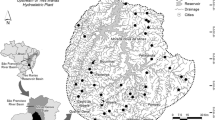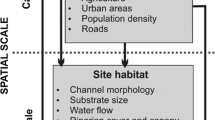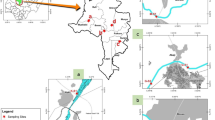Abstract
Various factors, such as habitat availability, competition for space, predation, temperature, nutrient supplies, presence of waterfalls, flow variability and water quality, control the abundance, distribution and productivity of stream-dwelling organisms. Each of these factors can influence the response of the density of organisms to a specific environmental gradient, inflating variability and making difficult to understand the possible causal relationship. In our study, we used quantile regression mixed models and Akaike’s information criterion as an indicator of goodness to examine two different datasets, one belonging to Italy and one belonging to Finland, and to detect the limiting action of selected environmental variables. In the Italian dataset, we studied the relationships among five macroinvertebrate families and three physical habitat characteristics (water velocity, depth and substratum size); in the Finnish dataset the relationships between taxa richness and 16 environmental characteristics (chemical and physical). We found limiting relationships in both datasets and validated all of them on different datasets. These relationships are quantitative and can be used to predict the range of macroinvertebrate densities or taxa richness as a function of environmental characteristics. They can be a tool for management purposes, providing the basis for habitat-based models and for the development of ecological indices.



Similar content being viewed by others
References
Allen, D. C. & C. C. Vaughn, 2010. Complex hydraulic and substrate variables limit freshwater mussel species richness and abundance. Journal of the North American Benthological Society 29: 383–394.
Annala, M., H. Mykrä, M. Tolkkinen, T. Kauppila, & T. Muotka, in press. Are biological communities in naturally unproductive streams resistant to additional anthropogenic stressors? Ecological applications [http://www.esajournals.org/doi/abs/10.1890/13-2267.1].
AQEM Consortium, 2002. Manual for the application of the AQEM system, Version 1.0. “The Development and Testing of an Integrated Assessment System for the Ecological Quality of Streams and Rivers throughout Europe using Benthic Macroinvertebrates”.
Arthur, J. W., J. A. Zischke & G. L. Ericksen, 1982. Effect of elevated water temperature on macroinvertebrate communities in outdoor experimental channels. Water Research 16: 1465–1477.
Åström, M., E. K. Aaltonen & J. Koivusaari, 2001. Effect of ditching operations on stream-water chemistry in a boreal forested catchment. The Science of the total environment 279: 117–129.
Austin, M., 2007. Species distribution models and ecological theory: a critical assessment and some possible new approaches. Ecological Modelling 200: 1–19.
Ayllón, D., A. Almodóvar, G. G. Nicola & B. Elvira, 2010. Modelling brown trout spatial requirements through physical habitat simulations. River Research and Applications 26: 1090–1102.
Bolker, B. M., M. E. Brooks, C. J. Clark, S. W. Geange, J. R. Poulsen, M. H. H. Stevens & J.-S. S. White, 2009. Generalized linear mixed models: a practical guide for ecology and evolution. Trends in ecology & evolution 24: 127–135.
Burnham, K. P. & D. Anderson, 2002. Model Selection and Multi-Model Inference. Springer, New York.
Cabrini, R., S. Canobbio, L. Sartori, R. Fornaroli & V. Mezzanotte, 2013. Leaf packs in impaired streams: the influence of leaf type and environmental gradients on breakdown rate and invertebrate assemblage composition. Water, Air, & Soil Pollution 224: 1697.
Cade, B. S. & B. Noon, 2003. A gentle introduction to quantile regression for ecologists. Frontiers in Ecology and the Environment 1: 412–420.
Cade, B. S., J. W. Terrell & R. L. Schroeder, 1999. Estimating effects of limiting factors with regression quantiles. Ecology 80: 311–323.
Calizza, E., M. L. Costantini, D. Rossi, P. Carlino & L. Rossi, 2012. Effects of disturbance on an urban river food web. Freshwater Biology 57: 2613–2628.
Campbell, R. E. & A. R. McIntosh, 2013. Do isolation and local habitat jointly limit the structure of stream invertebrate assemblages? Freshwater Biology 58: 128–141.
Canobbio, S., V. Mezzanotte, F. Benvenuto & M. Siotto, 2010. Determination of Serio River (Lombardy, Italy) ecosystem dynamics using macroinvertebrate functional traits. Italian Journal of Zoology 77: 227–240.
Canobbio, S., A. Azzellino, R. Cabrini & V. Mezzanotte, 2013. A multivariate approach to assess habitat integrity in urban streams using benthic macroinvertebrate metrics. Water Science and Technology 67: 2832–2837.
Clarke, R. T., J. F. Wright & M. T. Furse, 2003. RIVPACS models for predicting the expected macroinvertebrate fauna and assessing the ecological quality of rivers. Ecological Modelling 160: 219–233.
Davies, J. & A. Boulton, 2009. Great house, poor food: effects of exotic leaf litter on shredder densities and caddisfly growth in 6 subtropical Australian streams. Journal of the North American Benthological Society 28: 491–503.
Doll, J. C., 2011. Predicting biological impairment from habitat assessments. Environmental monitoring and assessment 182: 259–277.
Downes, B., 2010. Back to the future: little-used tools and principles of scientific inference can help disentangle effects of multiple stressors on freshwater ecosystems. Freshwater Biology 55: 60–79.
Fanny, C., A. Virginie, F. Jean-François, B. Jonathan, R. Marie-Claude & D. Simon, 2013. Benthic indicators of sediment quality associated with run-of-river reservoirs. Hydrobiologia 703: 149–164.
Folk, R. L., 1974. Petrology of Sedimentary Rocks. Hemphill Publishing, Austin.
Geraci, M., 2014. Linear quantile mixed models: the lqmm package for Laplace quantile regression. Journal of Statistical Software 57: 1–29.
Geraci, M. & M. Bottai, 2007. Quantile regression for longitudinal data using the asymmetric Laplace distribution. Biostatistics 8: 140–154.
Geraci, M. & M. Bottai, 2014. Linear quantile mixed models. Statistics and Computing 24: 461–479.
Gordon, N. D., T. H. McMahon, B. L. Finlayson, C. J. Gippel & R. J. Nathan, 2004. Stream Hydrology. Wiley, Chichester.
Gore, J. A., 1978. A technique for predicting in-stream flow requirements of benthic macroinvertebrates. Freshwater Biology 8: 141–151.
Gore, J. A., J. B. Layzer & J. Mead, 2001. Macroinvertebrate instream flow studies after 20 years: a role in stream management and restoration. Regulated Rivers: Research & Management 17: 527–542.
Gore, J., J. King & K. Hamman, 1991. Application of the instream flow incremental methodology to southern African rivers: protecting endemic fish of the Olifants River. Water SA 17: 225–236.
Grueber, C. E., S. Nakagawa, R. J. Laws & I. G. Jamieson, 2011. Multimodel inference in ecology and evolution: challenges and solutions. Journal of evolutionary biology 24: 699–711.
Hansen, J. & D. Hayes, 2012. Long-term implications of dam removal for macroinvertebrate communities in Michigan and Wisconsin Rivers, United States. River Research and Applications 28: 1540–1550.
Hart, D. D. & C. M. Finelli, 1999. Physical-biological coupling in streams: the pervasive effects of flow on benthic organisms. Annual Review of Ecology and Systematics 30: 363–395.
Hawkins, C. P., Y. Cao & B. Roper, 2010. Method of predicting reference condition biota affects the performance and interpretation of ecological indices. Freshwater Biology 55: 1066–1085.
Heino, J. & H. Mykrä, 2006. Assessing physical surrogates for biodiversity: do tributary and stream type classifications reflect macroinvertebrate assemblage diversity in running waters? Biological Conservation 129: 418–426.
Heino, J., T. Muotka & R. Paavola, 2003. Determinants of macroinvertebrate diversity in headwater streams: regional and local influences. Journal of Animal Ecology 72: 425–434.
Henning, K., H. Estrup & H. Schröder, 2005. Rejecting the mean: estimating the response of fen plant species to environmental factors by non-linear quantile regression. Journal of Vegetation Science 16: 373–382.
Holden, J., P. J. Chapman & J. C. Labadz, 2004. Artificial drainage of peatlands: hydrological and hydrochemical process and wetland restoration. Progress in Physical Geography 28: 95–123.
Johnson, J. B. & K. S. Omland, 2004. Model selection in ecology and evolution. Trends in ecology & evolution 19: 101–108.
Jowett, I. G., 1997. Instream flow methods: a comparison of approaches. Regulated Rivers: Research & Management 13: 115–127.
Kail, J., J. Arle & S. Jähnig, 2012. Limiting factors and thresholds for macroinvertebrate assemblages in European rivers: empirical evidence from three datasets on water quality, catchment urbanization, and river restoration. Ecological Indicators 18: 63–72.
Koenker, R., 2013. quantreg: quantile regression. R package version 4: 98.
Koenker, R. & G. Bassett, 1978. Regression quantiles. Econometrica 46: 33–50.
Lacan, I., V. Resh & J. R. McBride, 2010. Similar breakdown rates and benthic macroinvertebrate assemblages on native and Eucalyptus globulus leaf litter in Californian streams. Freshwater Biology 55: 739–752.
Lancaster, J. & L. Belyea, 2006. Defining the limits to local density: alternative views of abundance–environment relationships. Freshwater Biology 51: 783–796.
Lancaster, J. & B. J. Downes, 2010. Linking the hydraulic world of individual organisms to ecological processes: putting ecology into ecohydraulics. River Research and Applications 26: 385–403.
Lessard, J. & D. Hayes, 2003. Effects of elevated water temperature on fish and macroinvertebrate communities below small dams. River research and applications 19: 721–732.
Lytle, D. & N. Poff, 2004. Adaptation to natural flow regimes. Trends in Ecology & Evolution 19: 94–100.
Maddock, I., 1999. The importance of physical habitat assessment for evaluating river health. Freshwater biology 41: 373–391.
Mäki-Petäys, A., T. Muotka, A. Huusko, P. Tikkanen & P. Kreivi, 1997. Seasonal changes in habitat use and preference by juvenile brown trout, Salmo trutta, in a northern boreal river. Canadian Journal of Fisheries and Aquatic Sciences 54: 520–530.
Morrissey, C. A., A. Boldt, A. Mapstone, J. Newton & S. J. Ormerod, 2013. Stable isotopes as indicators of wastewater effects on the macroinvertebrates of urban rivers. Hydrobiologia 700: 231–244.
Ostermiller, J. & C. Hawkins, 2004. Effects of sampling error on bioassessments of stream ecosystems: application to RIVPACS-type models. Journal of the North American Benthological Society 23: 363–382.
Petrin, Z., 2011. Species traits predict assembly of mayfly and stonefly communities along pH gradients. Oecologia 167: 513–524.
Petrin, Z., H. Laudon & B. Malmqvist, 2007a. Does freshwater macroinvertebrate diversity along a pH-gradient reflect adaptation to low pH? Freshwater Biology 52: 2172–2183.
Petrin, Z., B. McKie, I. Buffam, H. Laudon & B. Malmqvist, 2007b. Landscape-controlled chemistry variation affects communities and ecosystem function in headwater streams. Canadian Journal of Fisheries and Aquatic Sciences 64: 1563–1572.
Poff, N., J. Allan & M. Bain, 1997. The natural flow regime. BioScience 47: 769–784.
Power, M. E., R. J. Stout, C. E. Cushing, P. Harper, F. R. Hauer, W. J. Matthews, P. B. Moyle, B. Statzner & I. R. Wais De Bagden, 1988. Biotic and abiotic controls in river and stream communities. Journal of the North American Benthological Society 7: 456–479.
R Core Team, 2013. R: A Language and Environment for Statistical Computing. R Foundation for Statistical Computing, Vienna.
Reid, D. J., J. M. Quinn & A. E. Wright-Stow, 2010. Responses of stream macroinvertebrate communities to progressive forest harvesting: influences of harvest intensity, stream size and riparian buffers. Forest Ecology and Management 260: 1804–1815.
Robinson, C. T., 2012. Long-term changes in community assembly, resistance, and resilience following experimental floods. Ecological Applications 22: 1949–1961.
Rosenfeld, J. & R. Ptolemy, 2012. Modelling available habitat versus available energy flux: do PHABSIM applications that neglect prey abundance underestimate optimal flows for juvenile salmonids? Canadian Journal of Fisheries and Aquatic Sciences 69: 1920–1934.
Sandin, L. & R. K. Johnson, 2004. Local, landscape and regional factors structuring benthic macroinvertebrate assemblages in Swedish streams. Landscape Ecology 19: 501–514.
Schmidt, T. S., W. H. Clements & B. S. Cade, 2012. Estimating risks to aquatic life using quantile regression. Freshwater Science 31: 709–723.
Schooley, R. & J. Wiens, 2005. Spatial ecology of cactus bugs: area constraints and patch connectivity. Ecology 86: 1627–1639.
Statzner, B. & B. Higler, 1986. Stream hydraulics as a major determinant of benthic invertebrate zonation patterns. Freshwater Biology 16: 127–139.
Statzner, B., K. Hoppenhaus, M.-F. Arens & P. Richoux, 1997. Reproductive traits, habitat use and templet theory: a synthesis of world-wide data on aquatic insects. Freshwater Biology 38: 109–135.
Tachet, H., P. Richoux, M. Bournaud & P. Usseglio-Polatera, 2000. Invertébrés d’eau douce. CNRS Editions, Paris.
Townsend, C. R., S. Dolédec & M. R. Scarsbrook, 1997. Species traits in relation to temporal and spatial heterogeneity in streams: a test of habitat templet theory. Freshwater Biology 37: 367–387.
Wagenhoff, A., C. R. Townsend & C. D. Matthaei, 2012. Macroinvertebrate responses along broad stressor gradients of deposited fine sediment and dissolved nutrients: a stream mesocosm experiment. Journal of Applied Ecology 49: 892–902.
Wright, J., 1995. Development and use of a system for predicting the macroinvertebrate fauna in flowing waters. Australian Journal of Ecology 20: 181–197.
Wright, J. F., 1992. Spatial and temporal occurrence of invertebrates in a chalk stream, Berkshire, England. Hydrobiologia 248: 11–30.
Acknowledgments
We are grateful to Anna Brusadelli for the help in macroinvertebrate identification and to Brian S. Cade for his helpful comments on an earlier version of the manuscript, in particular for the important tips about the use of quantile regression and AICc. We thank Timo Muotka and Heikki Mykrä for lending us their data. We also thank two anonymous referees for their constructive comments on a previous version of the manuscript.
Author information
Authors and Affiliations
Corresponding author
Additional information
Handling editor: Diego Fontaneto
Electronic supplementary material
Below is the link to the electronic supplementary material.
Rights and permissions
About this article
Cite this article
Fornaroli, R., Cabrini, R., Sartori, L. et al. Predicting the constraint effect of environmental characteristics on macroinvertebrate density and diversity using quantile regression mixed model. Hydrobiologia 742, 153–167 (2015). https://doi.org/10.1007/s10750-014-1974-6
Received:
Revised:
Accepted:
Published:
Issue Date:
DOI: https://doi.org/10.1007/s10750-014-1974-6




